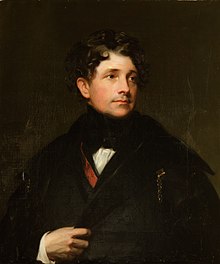Thomas Bradford
Sir Thomas Bradford | |
|---|---|
 Sir Thomas Bradford | |
| Born | 1 December 1777 |
| Died | 28 November 1853 (aged 75) |
| Allegiance | |
| Service/ | |
| Rank | Lieutenant-General |
| Commands held | Scotland Bombay Army |
| Awards | Knight Grand Cross of the Order of the Bath Knight Grand Cross of the Royal Guelphic Order |
Lieutenant-General Sir Thomas Bradford GCB GCH (1 December 1777 – 28 November 1853) was a British Army officer.
Military career[]
Bradford was commissioned as an ensign in the 4th (The King's Own) Regiment of Foot in October 1793 without purchase[1][2] He took part in the suppression of the Irish Rebellion of 1798, the Buenos Aires Expedition of 1806 as well as the battle of Vimeiro in 1808, battle of Corunna in 1809 and battle of Salamanca in 1812 during the Peninsular War.[1] He commanded a Portuguese division at the Battle of Vitoria, the Battle of San Sebastian and the Battle of the Nive, all in 1813.[1] For his service in the Peninsular he was awarded the Gold Medal with one clasp.[2]
He became General Officer Commanding the 7th Division of the Army of Occupation in France in 1815, Commander-in-Chief, Scotland in 1819 and Commander-in-Chief of the Bombay Army from 1825 to 1829.[1]
He was then Colonel of the 94th Regiment of Foot (1823–29) and, after returning to England, Colonel of the 30th Regiment of Foot (1829–46).[3]
He exchanged the Colonelcy of the 38th Foot for that of the 4th (The King's Own) Regiment of Foot in 1846, a position he held until his death in 1853.[4]
Family[]
He married Mary, the daughter of James Atkinson of Newcastle. His eldest son, James Henry Hollis Bradford, later changed his surname to Atkinson in compliance with the will of one Ralph Atkinson.[5] His brother, Lieutenant-colonel Sir Henry Hollis Bradford, was also a distinguished soldier wounded at Waterloo.[6]
References[]
- ^ Jump up to: a b c d National Army Museuem
- ^ Jump up to: a b "West Riding Militia". Doncaster Gazette. 29 April 1870. Retrieved 29 October 2015 – via British Newspaper Archive.
- ^ Gilbert Shepperd, The Connaught Rangers, p. 23
- ^ "General Sir Thomas Bradford GCB GCH". King's Own Royal Regiment Museum. Retrieved 2 July 2016.
- ^ The Gentleman's Magazine. W. Pickering. 1840. p. 425.
- ^ Dalton 1904, p. 35 & 97.
Sources[]
- Dalton, Charles (1904). The Waterloo roll call. With biographical notes and anecdotes. London: Eyre and Spottiswoode.
- 1777 births
- 1853 deaths
- People from Doncaster
- British Army generals
- British Army personnel of the Napoleonic Wars
- Knights Grand Cross of the Order of the Bath
- People of the Irish Rebellion of 1798